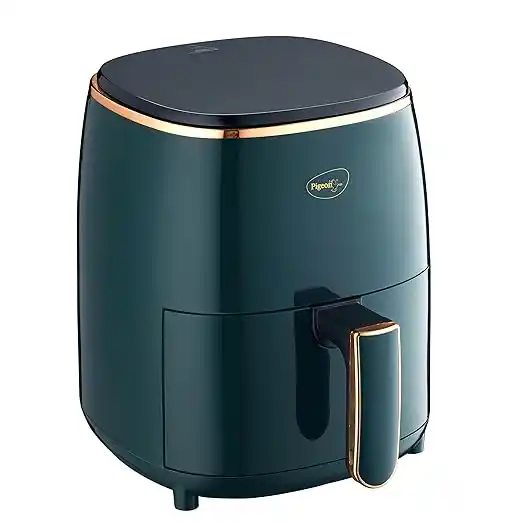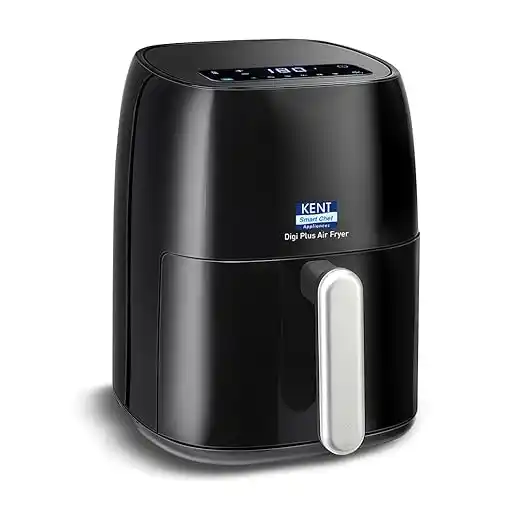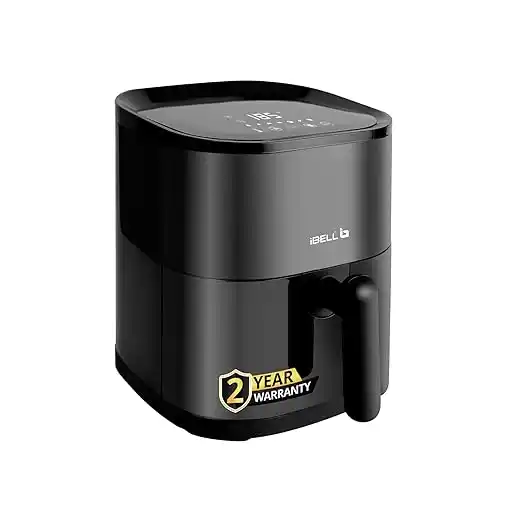Table of Contents
Drawbacks of Oil Frying:
- High Fat and Calorie Content: This is perhaps the most significant drawback of oil frying. Food absorbs a considerable amount of oil during the process, drastically increasing its fat and calorie content. This can contribute to weight gain and increase the risk of heart disease and other health problems if consumed frequently.
- Acrylamide Formation: High-temperature frying, especially with starchy foods like potatoes, can lead to the formation of acrylamide, a chemical compound classified as a potential carcinogen. While research is ongoing, limiting acrylamide intake is generally recommended.
- Mess and Cleanup: Deep frying is inherently messy. Splattering oil, lingering odors, and the oil disposal process can be cumbersome and time-consuming. Cleaning up a deep fryer or dealing with used oil is often a less-than-pleasant chore.
- Cost and Time: Heating a large amount of oil requires time and energy. Furthermore, the cost of cooking oil itself can add up, especially with frequent deep frying. Finally, the active cooking time might be quick, but preheating the oil and the cleanup process adds to the overall time investment.
The Modern Marvel: Air Frying Technology
Air frying, a relatively recent innovation, utilizes rapid air circulation to cook food. Essentially, an air fryer is a countertop convection oven that blasts hot air around the food, mimicking the crisping effect of deep frying but with significantly less oil. It has gained immense popularity, lauded as a “healthier” alternative to traditional frying.
Benefits of Air Frying:
- Significantly Reduced Fat and Calories: This is the major selling point of air frying. By using little to no oil (often just a tablespoon or less), air frying drastically reduces the fat and calorie content of fried foods. This makes it a much healthier option for those watching their weight or cholesterol levels.
- Lower Acrylamide Levels: Studies suggest that air frying generally produces less acrylamide compared to deep frying, especially when cooking at lower temperatures. This contributes to the perception of air frying as a healthier cooking method.
- Convenience and Ease of Use: Air fryers are incredibly convenient. They preheat quickly, cook food faster than conventional ovens, and are generally easier to clean than deep fryers. Many models come with pre-set programs, making cooking even simpler.
- Less Mess and Odor: Air frying is significantly less messy than oil frying. There’s no oil splattering, no lingering greasy smell, and cleaning is usually a matter of wiping down the basket or drawer.
- Faster Cooking Times: Due to the concentrated heat and rapid air circulation, air fryers often cook food faster than conventional ovens, and sometimes even faster than deep frying, depending on the food and recipe.
Drawbacks of Air Frying:
- Texture Difference: While air fryers excel at crisping, the texture is not always identical to deep-fried food. Air-fried food may be crispy, but it can sometimes be drier and lack the same level of richness and tenderness as authentically deep-fried items.
- Capacity Limitations: Air fryers typically have a limited capacity compared to deep fryers or ovens. This can be a constraint when cooking for larger groups or when preparing larger food items. Cooking in batches might be necessary, which can extend the overall cooking time.
- Cost of Appliance: Purchasing an air fryer requires an initial investment. While prices vary, they can be more expensive upfront compared to the equipment needed for deep frying.
- Learning Curve and Recipe Adjustments: While generally easy to use, achieving optimal results with air frying may require some experimentation and adjustments to cooking times and temperatures, especially when adapting recipes designed for deep frying or conventional ovens.
Oil Fry vs. Air Fry: A Side-by-Side Comparison
To better illustrate the differences, let’s summarize the key aspects in a table:
| Feature | Oil Frying | Air Frying |
| Taste & Texture | Rich, indulgent, crispy, consistently browned | Crispy, drier texture, can be less evenly browned |
| Health | High fat, high calorie, potential acrylamide | Low fat, low calorie, lower acrylamide |
| Convenience | Messy, time-consuming cleanup, oil disposal | Easy cleanup, minimal mess, convenient |
| Cost | Lower initial equipment cost, ongoing oil cost | Higher initial appliance cost, lower oil cost |
| Speed | Fast cooking, longer preheating and cleanup | Fast cooking, quick preheating, quick cleanup |
| Versatility | Highly versatile | Quite versatile, some limitations on wet batters |
As renowned chef Julia Child once famously said, “Everything in moderation… including moderation.” This wisdom applies perfectly to our frying debate.
Making the Right Choice for You
Ultimately, the choice between oil frying and air frying depends on your individual priorities and preferences.
Choose Oil Frying if:
- Taste and Authenticity are Paramount: If you prioritize the classic flavor and texture of truly deep-fried food and are willing to indulge occasionally, oil frying remains the gold standard.
- Budget is a Primary Concern (Initially): If you already have a pot and oil and are looking for the most budget-friendly starting point, oil frying might seem initially cheaper. However, consider the long-term cost of oil consumption and potential health implications.
- You Occasionally Need to Cook Larger Batches: If you regularly cook for large gatherings and need to fry significant quantities of food at once, traditional deep frying might be more efficient.
Choose Air Frying if:
- Health is a Top Priority: If you are health-conscious and looking to reduce your fat and calorie intake without completely sacrificing fried food enjoyment, air frying is an excellent choice.
- Convenience and Ease of Use are Key: If you value quick cooking, easy cleanup, and a hassle-free cooking experience, air frying shines.
- You Cook Smaller Portions Regularly: If you typically cook for yourself or a small family, the capacity limitations of air fryers are less likely to be an issue.
- You are Looking for a Versatile Kitchen Appliance: Many air fryers offer functionalities beyond just frying, such as baking, roasting, and grilling, making them a multi-purpose addition to your kitchen.
Conclusion:
Both oil frying and air frying have their place in the modern kitchen. Oil frying provides the authentic taste and texture that many crave, but it comes with significant health and convenience drawbacks. Air frying offers a healthier, more convenient alternative that can deliver surprisingly delicious and crispy results, albeit with a slightly different texture profile.
In our opinion, for everyday cooking and health-conscious individuals, air frying presents a compelling and practical solution to enjoy “fried” food more often and with less guilt. However, for those special occasions when you truly want to indulge in the authentic experience of deep-fried goodness, oil frying remains a time-honored tradition worth savoring in moderation. Ultimately, understanding the benefits and drawbacks of each method empowers you to make informed choices and enjoy the best of both worlds in your culinary journey.
FAQs
Q1: What are the factors to be considered while selecting oil fry or air fry?
A1: While selecting between oil fry and air fry, consider the type of food being cooked, the desired texture and taste, and the nutritional value. Oil frying is better suited for foods that require a crispy exterior and a tender interior, such as French fries and fried chicken. Air frying, on the other hand, is a healthier alternative for cooking foods that require minimal oil, such as vegetables and lean proteins.
Q2: How can oil frying be dangerous?
A2: Oil frying can be dangerous if not done properly. Overheating oil can lead to a fire, and splatters of hot oil can cause burns. Additionally, consuming excessive amounts of fried foods can increase the risk of heart disease, obesity, and other health problems. It’s also important to note that some oils, such as partially hydrogenated oils, can be harmful to health when heated to high temperatures.
Q3: Which oil is healthy for frying?
A3: Healthy oils for frying include avocado oil, grapeseed oil, and peanut oil, which have high smoke points and are rich in monounsaturated and polyunsaturated fats. These oils are less likely to become damaged when heated and can help retain the nutritional value of the food being cooked. Avoid using oils with low smoke points, such as olive oil, and those that are high in saturated fats, such as coconut oil.
Q4: What are some things not to do while adopting oil frying or air frying methods?
A4: Some things to avoid while oil frying or air frying include:
- Not heating the oil to the correct temperature, which can result in undercooked or overcooked food
- Overcrowding the fryer basket, which can lead to uneven cooking and a decrease in food quality
- Not patting dry food before cooking, which can cause excess moisture to lead to steaming instead of browning
- Not cleaning the fryer regularly, which can lead to the buildup of bacteria and other contaminants
- Using the same oil multiple times, which can lead to a decrease in oil quality and an increase in the risk of foodborne illness
Q5: Can air frying be as healthy as baking or grilling?
A5: Air frying can be a healthier alternative to deep-frying, but it may not be as healthy as baking or grilling. Air frying still uses some oil, although much less than deep-frying, and can produce a similar crispy texture. However, air frying can be a good option for those who want to indulge in fried foods occasionally, and it can be a healthier alternative to deep-frying when done properly.
Q6: How can I ensure food safety while oil frying or air frying?
A6: To ensure food safety while oil frying or air frying:
- Always wash your hands before and after handling food
- Use a food thermometer to ensure the oil reaches a safe temperature (usually between 325°F and 375°F)
- Never leave the fryer unattended
- Use a splatter guard to prevent hot oil from splashing
- Don’t overcrowd the fryer basket
- Cook food to the recommended internal temperature to prevent foodborne illness
Q7: Can I reuse oil after frying?
A7: It’s generally not recommended to reuse oil after frying, as it can become contaminated with bacteria and other contaminants. However, if you do choose to reuse oil, make sure to strain it through a cheesecloth or fine-mesh sieve to remove any food particles, and store it in an airtight container in the refrigerator. Reused oil should be used within a day or two, and it’s best to use a fresh batch of oil for each frying session to ensure the best flavor and texture.
Medical Disclaimer:
The information provided on this website is for general educational and informational purposes only and is not intended as a substitute for professional medical advice, diagnosis, or treatment. Always seek the advice of your physician or other qualified health provider with any questions you may have regarding a medical condition. Never disregard professional medical advice or delay in seeking it because of something you have read on this website.

Pigeon Health fry Digital Air Fryer, 360° High Speed Air Circulation Technology 1200 W with Non-Stick 4.2 L Basket – Green
| Special Feature | Digital |
| Product Dimensions | 30D x 22.9W x 29H Centimeters |
| Colour | Green |
| Capacity | 4.2 litres |
| Material | Stainless Steel, Plastic, Aluminium |
About this item
POWERFUL 1200W MOTOR: Rapid heating and consistent air throw performance, so you can whip up delicious meals in no time. Bring your family together with the Pigeon HealthiFRY Digital Airfryer, the ultimate solution for healthier, faster, and more convenient cooking, creating delicious memories and fostering a love for wholesome cooking among all family members – enjoy guilt free healthy snacks!
8 PRESET MENUS: Take the guesswork out of cooking with 8 pre-set menus – French Fries, Paneer Tikka, Samosa, Vegetable Roast, Pizza, Cutlets/Nuggets, Cakes, and Chips.
360° HIGH-SPEED AIR CIRCULATION: Enjoy perfectly crispy and evenly cooked delicious snacks, thanks to the advanced 360° high-speed air circulation technology. USES 95% LESS OIL: Enjoy guilt-free indulgence with up to 95% less oil than traditional cooking methods.
DIGITAL DISPLAY: Easily select modes / menus and monitor cooking times and temperatures.
DELAY START FUNCTION: Plan your meals ahead of time – Simply set the timer and let the HealthiFRY work its magic while you attend to other tasks.
DEFROST FUNCTION: Quickly and safely thaws frozen foods, so you can cook without delay. GENEROUS 4.2L EASY FOOD RELEASE BASKET: Spacious 4.2L easy foor release basket provides ample room to cook large batches of your favourite foods with ease.
VERY LOW NOISE: Enjoy a quiet cooking experience without the loud, distracting noise. STRONG BUILT QUALITY: Crafted with durability in mind – Coated durable & rust-proof basket and Coated Stainless Steel oil separator
With innovative features and unbeatable convenience, the Pigeon Healthy FRY Digital Air fryer is the perfect companion for busy home chefs and health-conscious foodies alike.


KENT Digi Plus Air Fryer | 4L Capacity & 1300W | Fry, Grill, Roast & Bake | Digital Display & Touch Control Panel | Rapid Heating | 80% Less Oil Usage | High Temperature & Uniform Heating | Black
| Special Feature | Temperature Control |
| Product Dimensions | 22.7D x 28.7W x 28.7H Centimeters |
| Colour | Black |
| Capacity | 4 litres |
| Material | Plastic |
About this item
Six Present Cooking Options: There are six pre-programmed cooking choices available, each with a pre-set default temperature and time.
Minimal Oil in Fried Food: With the KENT Digi Plus Air Fryer, you can indulge in mouth watering fried delicacies like samosas, fries, frozen meals, pizza, and kebabs without having to worry about consuming too much fat. While maintaining the same crispiness, taste, and texture of traditional deep-frying, this gadget uses up to 80% less oil.
Digital Display & Touch Control Panel : Your kitchen appliance is designed with easy-to-use digital control with LED display for easy reading and advanced touch screen technology. So, you simply select the menu, set the timer and temperature, and leave everything on this smart machine.
Varied Temperature: There is an intuitive temperature adjustment knob on this Digi Plus Air Fryer. Thus, you can choose to just turn left or right or change the temperature from 80˚ to 200˚.
Large Capacity: With a large capacity of up to 4L each batch, the KENT Digi Plus Air Fryer is quite capable. This appliance is a good option for serving a small gathering of guests or a family of three to four due to its capacity.


iBELL AEROFRY420DM Air Fryer 4.2 Litre – 1500W with Multiple Cooking Options, Dishwasher Safe, Non-stick Coating & Adjustable Temperature Control (Black)
| Special Feature | Adjustable Temperature, Dishwasher safe |
| Product Dimensions | 25D x 23W x 26H Centimeters |
| Colour | Black |
| Capacity | 4.2 litres |
| Material | Plastic |
About this item
1 Year standard warranty + 1 Year additional warranty on registration. (Registration should be done within 30 days from the date of Purchase).
Healthy Frying Made Easy: 1500W powerful motor and advanced air frying technology for crispy and healthy cooking results.
Versatile Cooking Options: Multiple preset cooking options for fries, chicken, steak, and more, allowing you to experiment with a wide range of recipes.
Easy Cleaning and Maintenance: Dishwasher safe parts and non-stick coating for effortless food release and convenient cleaning.
Precise Temperature Control: Adjustable temperature control (up to 200°C) for customized cooking, ensuring your dishes are cooked to perfection every time.




